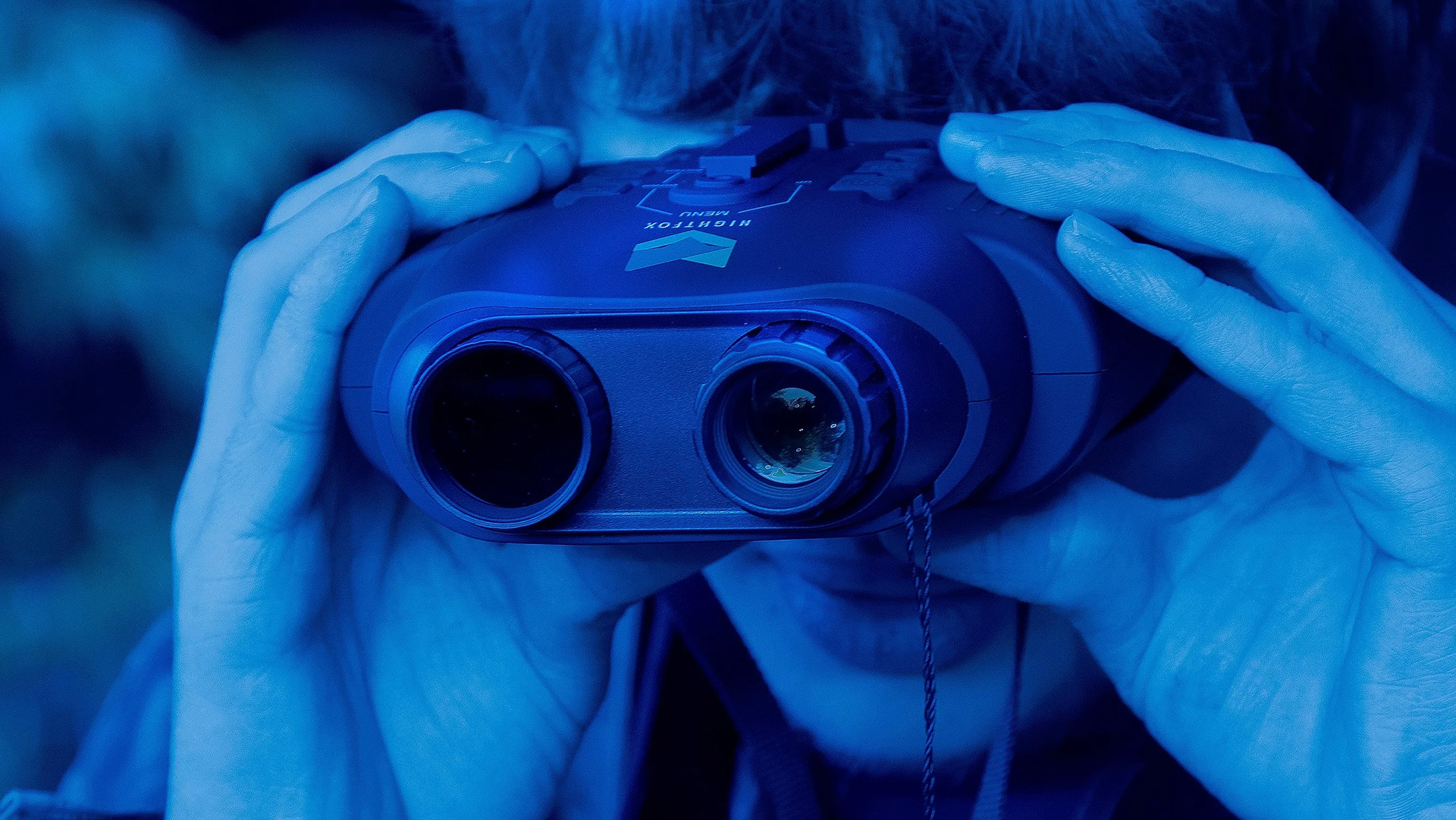How to choose a night vision device
Fancy a spot of nighttime wildlife observation but don’t know where to turn? Let this be your handy guide to all the ins and out of night vision technology


If you’re a keen wildlife observer, you’ll know all too well that the very best sightings are usually at late dusk, early dawn or during the full darkness of night when many species of nocturnal animals start hunting and foraging.
During the low light periods of dawn and dusk, even the best binoculars may have trouble focusing on a subject. And you can forget about them seeing anything at all once the moon’s popped out and everything’s turned pitch black.
This is where the best night vision binoculars and goggles come to the rescue. Night vision devices (or NVDs for short) primarily rely on image intensification technology, infrared and, in extreme cases, thermal imaging.
They have become increasingly popular for a variety of activities, from wildlife observation, hunting and wilderness camping to working outdoors in low light conditions, security patrolling, law enforcement and, of course, military use. NVDs not only allow you to see clearly in total darkness, but they can also magnify what you see in surprisingly good detail.
However, with so many different types of night vision devices on the market, choosing the right model can be a daunting prospect, especially if you’re entering the NVD market for the first time. With that in mind, we’ve created this handy guide which will hopefully help you understand how best to choose the most suitable night vision device for you.
Without further ado, let’s flick a switch and start turning night into day.
How night vision technology works

NVDs use a combination of image intensification technology and infrared illuminators that amplify ambient light, making objects visible in very low-light conditions and even in complete darkness. In fact, in much the same way, your home security camera is capable of highlighting activity in total darkness, so it is with night vision devices.
Get all the latest news, reviews, deals and buying guides on gorgeous tech, home and active products from the T3 experts
Unlike standard binoculars that feature two lens barrels, each fitted with an array of precision glass lenses to magnify a subject and its surroundings, NVDs usually have just one objective lens barrel married to a shorter infrared illuminating barrel.
The lens barrel is fitted with a highly sensitive camera-style CCD (Charge-Coupled Device) image sensor that transfers the CCD’s digital signal onto a mini display that’s usually fitted inside either a single monocular eyepiece or a larger protected smartphone-style monitor. To all intents and purposes, the resulting image in the display is akin to watching a mini TV screen or a subject in a bridge camera’s digital monitor.
Of course, given all the digital and IR technology on board, all NVDs require a set of batteries to operate so always have some spares to hand. One major bonus of NVDs is that they can record and save everything onto an SD card, whether it’s a still image of a bull elephant in the bush or a video of a lion kill unfolding before you from the safety of your safari vehicle.
Just be mindful that night vision results are nowhere near as sharp or detailed as a pair of binoculars in bright daylight. In most cases, the image that you see is displayed in slightly fuzzy black and white and, in some instances, in the colour green since our eyes are more capable of looking at green-tinted imagery for extended periods without getting tired.
Choosing the best night vision device for you

If you rarely go wildlife spotting in the dead of night when you can’t see a thing with the naked eye, you might not need a model fitted with infrared. Like any decent digital camera, a good night vision device fitted with standard image intensification technology will capture a great deal of detail in most low-light conditions.
You’ve likely seen the results of this when you’ve taken a digital photo of a very dark scene, and yet when you look at the resulting photo, it appears to be much brighter than what you witnessed with the naked eye. The same applies to televised sports where on the TV screen, it looks like mid-afternoon light when, in reality, it’s early dusk.
However, if you want to experience full night vision capabilities in complete darkness when you literally cannot see your hand in front of your face, you will most certainly need a model fitted with infrared illumination. IR is a remarkable thing, but it’s an admittedly creepy moment the first time you look through a night vision device fitted with IR.
Picture yourself in your local woods where you're trying out your new purchase for the first time. The second you switch them on, your eyeballs are filled with a scene from The Blair Witch Project. Every tree trunk, branch and blade of grass is clearly illuminated in high contrast monochrome, and you can easily see well enough to walk briskly through the woods without tripping. In a nutshell, it might take you a while to adjust to what at first feels like some weird virtual reality horror movie experience.
Night vision devices come in three main styles – single-barrel monocular, twin-barrel binocular with one barrel devoted to infrared and, for the full hands-free Call of Duty: Modern Warfare III effect, a head-mounted model. If using a binocular or monocular model, you’re advised to attach them to a tripod because the more the image is magnified, the less steady it will be. Thankfully, some high-end models are equipped with onboard digital image stabilisation.
Key considerations to look out for when choosing a night vision device
Magnification and field of view
Magnification determines how close you can view distant objects. However, higher magnification will reduce the field of view, so it’s best to balance your need for magnification with a practical FOV for your intended application. For instance, a wider field of view is often preferred for activities like wildlife observation and hunting, where situational awareness is crucial.
Infrared illumination
As detailed above, an infrared illuminator is essential in total darkness. This feature enhances visibility by emitting infrared light that is invisible to the human eye but detected by the night vision device. Higher-end models have an infrared range of up to 300 metres, while lower-spec NVDs tend to have a much lower range. That said, in general, even the cheapest IR-equipped NVDs will provide enough range to see everything clearly up to about 70 metres away.
Image resolution
Higher resolution results in clearer and more detailed recorded images, so always opt for a model with a resolution of, say, 1080p or 4K to ensure better quality videos and stills.
Durability and weather resistance
If you anticipate exposure to harsh weather conditions or rough handling, opt for a model with a durable, weather-resistant build. The best models for use near water or in heavy rain will have IP ratings of between IP5 (protected against jets of water) and IP7 (protection against the effects of immersion in water up to one metre in depth for 30 minutes.
Battery Life
Battery life is critical, especially for extended use, so consider the type of batteries required and whether they are readily available. Some devices offer rechargeable battery options, which can be cost-effective and environmentally friendly in the long run. However, on outdoor products like NVDs, sometimes it’s better to opt for a model that can run on standard alkaline batteries, which are easily swappable when out in the field.
Price
Night vision devices come in a wide price range, from around £199/ $200 to over £20,000/ $20,000. Obviously, the more you spend, the better the optics, but it’s a case of diminishing returns once you head over the heady £2,000/ $2,000 price bracket.
Now you know the basic ins and outs of night vision technology, head over to Amazon or your favourite optical store and start seeing the world like our fellow nighttime creatures.
Derek (aka Delbert, Delvis, Delphinium, Delboy etc) specialises in home and outdoor wares, from coffee machines, white appliances and vacs to drones, garden gear and BBQs. He has been writing for more years than anyone can remember, starting at the legendary Time Out magazine – the original, London version – on a typewriter! He now writes for T3 between playing drums with his bandmates in Red Box (redboxmusic).
